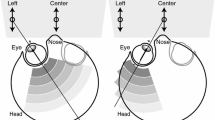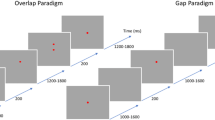Summary
The source dipoles for blinks point radially whereas the source dipoles for saccades point tangentially, in the direction of the eye movement. This indicates that blink potentials are not generated by eye movements but by the eyelid sliding down over the positively charged cornea. Dipole source dipole analysis shows that the “rider artifact” at the onset of upward and lateral saccades is caused by the eyelid as it lags a little behind the eyes at the beginning of the movement. Dipole source analysis allows both the EEG and the EOG to be modeled simultaneously and EOG generators to be distinguished from nearby EEG generators. Ocular source components can be calculated from a principal component analysis of EEG and EOG recordings during blinks and saccades. The effectiveness of propagation factors, source dipoles and source components in removing ocular artifacts from EEG samples was assessed. The most effective correction procedure uses source components.
Similar content being viewed by others
References
Barlow, J.S. and Rémond, A. Eye movement artifact nulling in EEGs by multichannel on-line EOG subtraction. Electroencephalogr. Clin. Neurophysiol., 1981: 418–423.
Barry, W. and Jones G.M. Influence of eye lid movement upon electro-oculographic recording of vertical eye movements. Aerosp. Med., 1965, 36: 855–858.
Becker, W. and Fuchs, A.F. Lid-eye coordination during vertical gaze changes in man and monkey. J. Neurophysiol., 1988, 60: 1227–1252.
Berg, P. and Scherg, M. Dipole models of eye movements and blinks Electroencephalogr. Clin. Neurophysiol., 1991a, 79: 36–44.
Berg, P. and Scherg, M. Dipole modeling of eye activity and its application to the removal of eye artifacts from the EEG and MEG. Clin. Phys. Physiol. Meas., 1991b; 12 (Supplement A): 49–54.
Brunia, C.H.M., Mocks, J., van den Berg-Lenssen, M.M.C. et al. Correcting ocular artifacts in the EEG: A comparison of several methods. J. Psychophysiol., 1989, 3: 1–50.
Collewijn, H., Van Der Steen, J. and Steinman, R.M. Human eye movements associated with blinks and prolonged eyelid closure. J. Neurophysiol., 1985, 54: 11–27.
Elbert, T., Lutzenberger, W., Rockstroh, B. and Birbaumer, N. Removal of the ocular artifacts from the EEG—A biophysical approach to the EOG. Electroencephalogr. Clin. Neurophysiol., 1985, 60: 455–463.
Evinger, M.D., Shaw, C.K., Manning, K.A. and Baker, R. Blinking and associated eye movement in humans, guinea pigs and rabbits. J. Neurophysiol., 1984, 52: 323–38.
Gasser, T., Sroka, L. and Mocks, J. The correction of EOG artifacts by frequency dependent and frequency independent methods. Psychophysiology, 1986, 23: 704–712.
Gratton, G., Coles, M.G.H. and Donchin, E. A new method for off-line removal of ocular artifact. Electroencephalogr. Clin. Neurophysiol., 1983, 55: 468–484.
Häkkinen, V., Hirvonen, K., Hasan, J., Kataja, M., Värri, A., Loula, P. and Eskola, H. Effects of small differences in electrode positions on EOG signals. Application to vigilance studies. Electroencephalogr. Clin. Neurophysiol., 1993, 86: 294–300.
Hector, M.L. EEG recording. Butterworths, London, 1976.
Hillyard, S.A. and Galambos, R. Eye movement artifact in the CNV. Electroencephalogr. Clin. Neurophysiol., 1970, 28: 173–182.
Ifeachor, E.C., Jervis, B.W., Allen, E.M., Moris, E.L., Wright, D.E. and Hudson, N.R. Investigation and comparison of some models for removing ocular artifacts from EEG signals. Med. Biol. Eng. Comput., 1988, 26: 584–590; 591–598.
Jervis, B.W., Nichols, M.J., Allen, E.M., Hudson, N.R. and Johnson, T.E. The assessment of two methods for removing eye movement artifact from the EEG. Electroncephalogr. Clin. Neurophysiol., 1985, 61: 444–452.
Jervis, B.W., Ifeachor, E.C. and Allen, E.M. The removal of ocular artifacts from the electroencephalogram: a review. Med. Biol. Eng. Comput., 1988, 26: 2–12.
McCallum, W.C. and Walter, W.G. The effects of attention and distraction on the contingent negative variation in normal and neurotic subjects. Electroencephalogr. Clin. Neurophysiol., 1968, 25: 319–329.
Möcks, J. and Verlenger R. Multivariate methods in biosignal analysis: application of principal component analysis to event-related potentials. In: R. Weitkunat (Ed.), Digital Biosignal Processing. Techniques in the Behavioral and Neural Sciences. Vol 5. Amsterdam, Elsevier, 1991: 399–458.
Nunez, P.L. and Katznelson, R.D. Electric fields of the brain: the neurophysics of EEG Oxford, New York, 1980.
Scherg, M. Fundamentals of dipole source analysis. In: M. Hoke, F. Grandori and G.L. Romani (Eds.), Advances in Audiology, Vol 6. Auditory Evoked Magnetic Fields and Potentials. Basel, Karger, 1990: 40–69.
Scherg, M. and Von Cramon, D. Dipole source potentials of the auditory cortex in normal subjects and patients with temporal lobe lesions. In: F. Grandori, M. Hoke and G.L. Romani (Eds.), Advances in Audiology, Vol 6. Auditory Evoked Magnetic Fields and Potentials. Basel, Karger, 1990: 165–193.
Scherg, M. and Picton, T.W. Separation and identification of event-related potential components by brain electric source analysis. In: C.H.M. Brunia, G. Mulder and M.N. Verbaten (Eds.), Event-Related Potentials of the Brain. Electroencephalogr. Clin. Neurophysiol., Suppl. 42, Elsevier, Amsterdam, 1991: 24–37.
Scherg, M. Functional imaging and localization of electromagnetic brain activity. Brain Topography, 1992, 5: 103–111.
Semlitsch, H.V., Anderer, P., Schuster, P. and Presslich, O. A solution for reliable and valid reduction of ocular artifacts, applied to the P300 ERP. Psychophysiology, 1986, 23: 965–703.
Whitton, J.L., Lue, F. and Moldofsky, H. A spectral method for removing eye movement artifacts from the EEG. Electroencephalogr. Clin. Neurophysiol., 1978, 44: 735–741.
Author information
Authors and Affiliations
Additional information
This research was supported by a grant from the Medical Research Council of Canada (MA5465) and a NATO collaborative research grant (0330/88). The programming for the analysis of ocular source components was supported by a grant from the James S. McDonnell Foundation (Grant 90-174, principal investigator Edgar Zurif). Dick Mowrey provided programming assistance.
Rights and permissions
About this article
Cite this article
Lins, O.G., Picton, T.W., Berg, P. et al. Ocular artifacts in recording EEGs and event-related potentials II: Source dipoles and source components. Brain Topogr 6, 65–78 (1993). https://doi.org/10.1007/BF01234128
Accepted:
Issue Date:
DOI: https://doi.org/10.1007/BF01234128




